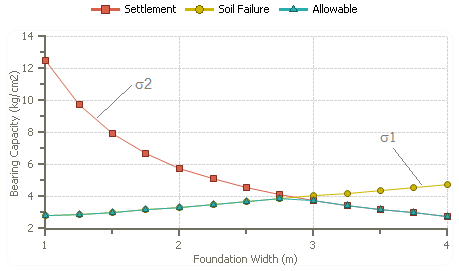Theory (Bearing Capacity)
For strip and pad footings, PEYSANJ calculates both shear failure and settlement criteria for a range of footing widths (i.e. B1 to B2). At each footing size:
1- Shear Failure: The allowable bearing pressure based on shear failure (σ1) is calculated.
2- Settlement: For settlement control, stress is increased from zero to σ1 (calculated above) with Δσ increments. At each step, settlement is calculated and compared with the allowable settlement specified by user. Once the settlement has met the user's criterion, this stress (σ2) is recorded as the allowable stress based on settlement.

3- Allowable Stress: Then σ1 and σ2 are compared at each footing size, and minimum of these two values is introduced as the allowable bearing capacity.
For spread (mat) foundations, however, due to relatively larger footing size, shear failure will not be a limiting criterion. Therefore settlement of the footing is calculated and plotted versus stress. This stress can be set by user to vary from σ1 to σ2 with Δσ increment specified by user. This procedure can be configured by user through Options page.
Shear Failure Analysis
PEYSANJ performs bearing capacity analysis of the footings based on Hansen equations, which is a modified version of original Terzaghi bearing capacity. The effect of water level in bearing capacity is taken into account using the method recommended by Braja M. Das in the book "Principles of Foundation Engineering" (6th Edition), Section 3.5 titled "Modification of Bearing Capacity Equations for Water Table".
Settlement Analysis
Three methods can be chosen for elastic (immediate) settlement calculation of footings. For further reference and detailed description of each methodology please refer to reference books. For the purpose of calculating 1-D Terzaghi consolidation settlement, stress increase dP is calculated at the top, middle and the bottom of the layer and an average is calculated δPave=(δpt+4δPm+δPb)/6
If "Goodier and Timoshenko" method is used for elastic settlement calculation, then stress influence depth H should be calculated first. In this section user can choose how H is calculated. Usually H is taken as the depth in which δP is reached a certain percentage of the stress below footing, where this percentage can be defined by user in Options page.
In general, the total settlement is defined as below in PEYSANJ software:
S = Ir (Se+α.Sc)
where:
Ir : Rigidity factor (between zero and one; usually more than 0.9). The idea is to allow a rigid foundation to decrease the total settlement due to its ability to uniformly spread the stress.
Se : Elastic settlement
Sc: Consolidation settlement
α: User can specify what percentage of consolidation settlement should be considered in the total settlement calculation. The default value is 1. However, user can choose a lower value if the layer is not saturated to account for lower moisture contents in clay/silt layer:
